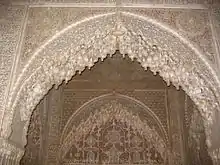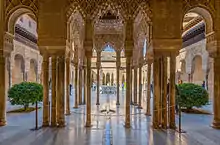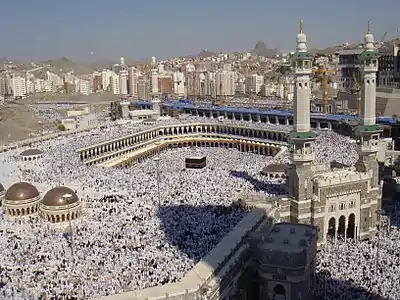Yeseria
Yesería is a term that refers to decoratively carved or molded stucco and plaster. Used widely throughout the Mediterranean region, it reached a creative pinnacle during the Nasrid dynasty (1238-1492) on the Iberian peninsula.[1] Mudejar architecture also made broad use of yesería. Recent scholarship is revealing details about the original stylistic designs, methods and materials on yesería of the Mudéjar period.[2]
History
The use of carved stucco has been documented back to ancient times. The Umayyad dynasty were noted for their use of carved stucco in their architecture.[3] Examples of early 8th century carved stucco survive at the Umayyad ruins at Khirbat al Mafjar. The Umayyad dynasty brought Islam to the Iberian peninsula in the 8th century. They also brought their characteristic art and architecture where it developed and flourished into architectural masterpieces such as Mosque–Cathedral of Córdoba and the Alhambra, replete with yesería.[4] As Christian kings conquered the Iberian peninsula, they continued to use Islamic style in their own buildings to demonstrate their new dominion over the previous Muslim area.
Islamic and Mujédar yesería followed four basic types of ornamentation; calligraphic, geometric lazo, arabesque and muqarnas. Muqarnas were most typically found on vaults, capitals, friezes, and ceilings. Walls were covered with the remaining ornamental types, intermixed and arranged for visual appeal and impact.[2] In Nasrid and Mudéjar architecture, the lower section or dado section of wall was typically covered in tile. Yesería covered the remaining wall above the dado.
Material
The term stucco has a variety of meanings. It can refer to style, material, and method. In Islamic art, stucco is used to define decoration made from gypsum materials.[5] The composition and color of stucco varied depending upon the purity of gypsum stone and additives used to bestow properties to the mixtures such as hardness, setting time, and binding.[2] Yesería is the Spanish word for plaster work. In art history, the term yesería is most often associated with carved stucco or plaster on the Iberian peninsula and Latin America.(6)
The chemical formula for gypsum is CaSO4-2H2O. Gypsum is the most common sulfate mineral.[6] The combination of abundant source material, ease of preparation and handling, wide adaptability for use, and quick setting time accounted for stucco’s widespread use.[2] Like stucco, the word plaster has a variety of uses. Stucco and plaster are often used interchangeably when referring to its use as a decorative or ornamental. In Mudéjar architecture, plaster can also refer to plaster of paris which was used in restoration and redecoration at later dates over the original stucco layer.[2]
Technique
The two basic techniques for creating yesería were carving in situ or mold cast which was then adhered to the structure. Hand carving was accomplished by initially tracing design onto applied stucco layer and then carving using simple hand tools.[1] Casting allowed for more elaborate and intricate designs that could be repeated creating systematic stylization. Analysis of the original yesería in the Alhambra show that Nasrid artisans were well versed in the properties of stucco and used different gypsum mixtures for carving and casting. For example, additives to slow drying and setting were used on stucco mixtures that were carved in place to allow artisans more time to complete their work.[2]
Yesería was often polychromed. Age and weather, along with centuries of redecoration and restoration have significantly altered the original appearance of most yesería that date to the Mudéjar period and earlier.[2] Current advances in analytical instrumentation that allows for in situ analysis of the stucco are yielding information about original pigments and techniques.[7] A further example of Nasrid artisans skill with stucco was their use of high purity gypsum coating that served both as a sealant and a preparatory stage for subsequent painting or gilding on the original stucco layer. The Alhambra has been the focus of recent investigations. The primary colors used on the yesería of the Alhambra were red, blue, green, golden, and black. Spectroscopic analysis of pigments attributed to original decoration of the Alhambra show cinnabar as the pigment used for red color. Lapis lazuli, a highly prized and expensive pigment accounts for the blue. Malachite has been detected as the source of the green hues. Carbon black was used for black pigment.[8] Gilding, especially on the muqarnas has been noted. The application of both pigment and gilding to these geometrically complex ceilings showed their knowledge and skill in optical allusion and spatial harmony. Investigations have focused on the muqarnas ornamented ceiling in the Hall of Kings in the Alhambra. Data is revealing the expansive use of two of the most expensive materials on this ceiling, lapis lazuli and gold leaf revealing the original dazzling opulence of the space.[9]
Gallery
| Wikimedia Commons has media related to Yeserias. |
| Wikimedia Commons has media related to Islamic plaster sculpture. |
See also
- Pargetting for another tradition of decorative plasterwork
- Mudéjar architecture
References
- Victoria and Albert Museum, Online Museum (2012-02-02). "Nasrid Plasterwork: Symbolism, Materials & Techniques". www.vam.ac.uk. Retrieved 2020-11-26.
- Bush, Olga (2018-05-01). Reframing the Alhambra. Edinburgh University Press. ISBN 978-1-4744-1650-4.
- Hamilton, R. W. (1953). "Carved Plaster in Umayyad Architecture". Iraq. 15 (1): 43. doi:10.2307/4199565. ISSN 0021-0889.
- www.metmuseum.org http://www.metmuseum.org/toah/hd/sumay/hd_sumay.htm. Retrieved 2020-11-26. Missing or empty
|title=(help) - Al-Qantara. Editorial CSIC.
- "Geology and Earth Science News, Articles, Photos, Maps and More". geology.com. Retrieved 2020-11-26.
- Dominguez-Vidal, A.; de la Torre-López, M. J.; Campos-Suñol, M. J.; Rubio-Domene, R.; Ayora-Cañada, M. J. (2014-01-22). "Decorated plasterwork in the Alhambra investigated by Raman spectroscopy: comparative field and laboratory study". Journal of Raman Spectroscopy. 45 (11–12): 1006–1012. doi:10.1002/jrs.4439. ISSN 0377-0486.
- Dominguez-Vidal, Ana; Jose de la Torre-Lopez, Maria; Rubio-Domene, Ramon; Ayora-Cañada, Maria Jose (2012). "In situ noninvasive Raman microspectroscopic investigation of polychrome plasterworks in the Alhambra". The Analyst. 137 (24): 5763. doi:10.1039/c2an36027f. ISSN 0003-2654.
- de la Torre-López, Maria Jose; Dominguez-Vidal, Ana; Campos-Suñol, Maria Jose; Rubio-Domene, Ramon; Schade, Ulrich; Ayora-Cañada, Maria Jose (2014-02-24). "Gold in the Alhambra: study of materials, technologies, and decay processes on decorative gilded plasterwork". Journal of Raman Spectroscopy. 45 (11–12): 1052–1058. doi:10.1002/jrs.4454. ISSN 0377-0486.
External links
Nasrid Plasterwork: Symbolism, Materials & Techniques (info on 'naqch hadîda' technique)



.jpg.webp)




.jpg.webp)


_38.JPG.webp)




.jpg.webp)
_06.JPG.webp)


.jpg.webp)







.jpg.webp)


.jpeg.webp)
